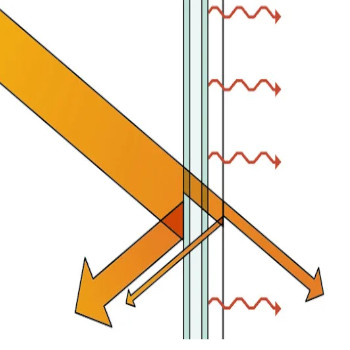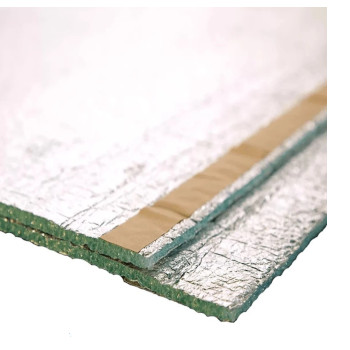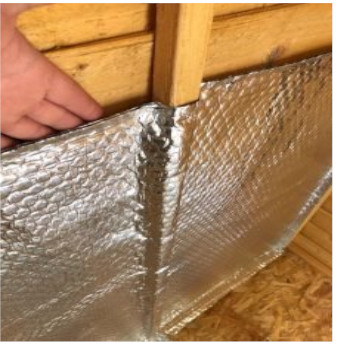
DO I NEED AN AIR GAP WHEN USING FOIL INSULATION?*
When it comes to insulating our homes, we want to make sure we're doing everything we can to keep the warm air inside during the winter and the cool air inside during the summer. One type of insulation that has gained popularity in recent years is foil insulation. Foil insulation is made up of a layer of foil, which reflects radiant heat which helps to trap air and prevent heat loss. However, many people wonder if an air gap is necessary when using foil insulation. In this blog, we'll explore the answer to this and other related questions to help you make an informed decision about how to insulate your home effectively.
HOW FOIL INSULATION WORKS: REFLECTING HEAT INSTEAD OF ABSORBING IT
 Foil insulation works differently than traditional insulation materials. Rather than absorbing heat, it reflects it. This is because of the reflective surface of the foil layer.
Foil insulation works differently than traditional insulation materials. Rather than absorbing heat, it reflects it. This is because of the reflective surface of the foil layer.
When radiant heat strikes a surface, it can be absorbed, transmitted, or reflected. Foil insulation takes advantage of this by reflecting the radiant heat back to its source, rather than allowing it to be absorbed into the insulation material. The reflective surface of the foil layer creates a barrier that prevents heat from passing through the insulation and into the living space.
The effectiveness of foil insulation can be increased by leaving an air gap between the foil layer and the surface it's installed on. This allows the foil to reflect radiant heat even more effectively, creating an additional layer of insulation that helps to maintain a consistent temperature in the living space.
One of the benefits of using foil insulation is that it's lightweight and easy to install. It's also relatively affordable compared to other types of insulation materials.
Additionally, because it reflects heat rather than absorbing it, foil insulation can help to reduce cooling costs in the summer by preventing radiant heat from entering the living space.
In summary, foil insulation works by reflecting radiant heat back to its source, rather than allowing it to be absorbed into the insulation material. By creating a barrier that prevents heat from passing through the insulation and into the living space, it helps to maintain a consistent temperature and can help to reduce energy costs. To find out what are the benefits of foil insulation click here.
DOES RADIANT BARRIER WORK WITHOUT AN AIR GAP?
 Radiant barriers are a type of reflective insulation that work by reflecting radiant heat away from the living space. They are often used in hot climates to reduce cooling costs by preventing radiant heat from entering the home.
Radiant barriers are a type of reflective insulation that work by reflecting radiant heat away from the living space. They are often used in hot climates to reduce cooling costs by preventing radiant heat from entering the home.
While radiant barriers are designed to work with an air gap, they can still be effective even without one. The key to their effectiveness is the reflective surface, which is designed to reflect radiant heat away from the living space.
However, without an air gap, the effectiveness of a radiant barrier may be reduced. This is because an air gap provides an additional layer of insulation that helps to prevent heat from passing through the barrier and into the living space.
If you are installing a radiant barrier, it's recommended to leave an air gap of at least 25mm (1 inch) between the barrier and the surface it's installed on. This allows for proper ventilation and helps to prevent moisture buildup, which can impact the effectiveness of the barrier.
It's important to note that radiant barriers should not be used as a substitute for traditional insulation materials such as fibreglass or mineral wool. While they can be effective at reflecting radiant heat, they do not provide the same level of insulation as traditional materials.
DO INSULATION BOARDS NEED AN AIR GAP?
When it comes to insulation, it's generally recommended to leave a gap between the insulation material and any other surfaces, such as walls, ceilings, or roofs. This gap provides ventilation and prevents moisture buildup, which can lead to mould and other problems.
Insulation boards are no exception to this rule, and it's important to leave an air gap between them and the surface they're installed on. For example, if you're installing insulation boards in your attic, you'll want to make sure there's an air gap between the boards and the roof. This will help to prevent moisture buildup and improve the effectiveness of the insulation.
The same applies to foil insulation, which also requires an air gap. Foil insulation is particularly effective at reflecting radiant heat, which can be beneficial in both summer and winter. However, in order for it to work effectively, there needs to be an air gap between the foil layer and the surface it's installed on. This gap allows the foil to reflect the heat, rather than simply absorbing it.
In summary, whether you're using insulation boards or foil insulation, it's important to leave an air gap to improve the effectiveness of the insulation and prevent moisture buildup.
DOES AN AIR GAP IMPROVE INSULATION?
Yes, an air gap can significantly improve the effectiveness of insulation. This is because air is actually a good insulator in itself. When an air gap is present between the insulation material and a surface, it creates an additional layer of insulation by trapping air in that space. This trapped air acts as a buffer between the inside and outside temperatures, helping to maintain a consistent temperature and prevent heat loss or gain.
In fact, even a small air gap can have a significant impact on the effectiveness of insulation. Each centimetre of air space between the insulation and the surface is equivalent to an additional layer of insulation. This means that a small air gap can significantly improve the R-value (the measure of insulation's ability to resist heat flow) of the insulation.
Additionally, the presence of an air gap can help with ventilation. It allows air to circulate and prevents moisture buildup, which can be a problem in poorly ventilated spaces. This helps to maintain good air quality and prevent the growth of mould and mildew.
In summary, an air gap is an important element of effective insulation. It provides an additional layer of insulation by trapping air and helps to prevent moisture buildup by allowing for ventilation. So, it's always recommended to leave an air gap when installing insulation, whether it's in your walls, roof, or floors.
MINIMUM AIR GAP FOR INSULATION: WHAT SIZE SHOULD YOU LEAVE?
The size of the air gap needed for insulation can vary depending on the type of insulation and the location where it's installed. However, there are some general guidelines you can follow.
WALLS & CEILINGS
For example, in walls and ceilings, it's recommended to leave an air gap of at least 25mm (1 inch) between the insulation and the surface. This allows for ventilation and helps to prevent moisture buildup.
ROOFS
In roofs, the air gap should be larger, typically around 50mm (2 inches), to allow for proper ventilation and prevent condensation.
It's important to note that some insulation materials, such as spray foam, do not require an air gap. However, if you're using traditional insulation materials such as fibreglass or mineral wool, it's important to follow the manufacturer's guidelines for air gap size and placement.
FOIL INSULATION
When it comes to foil insulation, it's generally recommended to leave an air gap of at least 25mm (1 inch) between the foil layer and the surface it's installed on. This allows the foil to reflect radiant heat, rather than simply absorbing it. It also provides ventilation and helps to prevent moisture buildup, which can impact the effectiveness of the insulation.
DO YOU NEED AN AIR GAP BETWEEN FOIL INSULATION AND PLASTERBOARD?
When it comes to insulating a wall or ceiling, one common question is whether or not you need to leave an air gap between the foil insulation and plasterboard. The answer depends on the type of insulation you are using.
For traditional insulation materials such as fibreglass or mineral wool, it's not necessary to leave an air gap between the insulation and plasterboard. These materials are designed to be in direct contact with the plasterboard and work by slowing down the transfer of heat through the wall or ceiling.
However, if you are using foil insulation or a radiant barrier, it's recommended to leave an air gap between the insulation and plasterboard. This is because the reflective surface of the foil layer works by reflecting radiant heat, and an air gap provides an additional layer of insulation that helps to prevent heat from passing through the barrier and into the living space.
SHOULD I LEAVE AN AIR GAP WHEN INSULATING A SHED?
 If the shed is going to be used as a gym or workshop, where maintaining a consistent temperature is important, it may be worth considering leaving an air gap and using foil insulation to maximise the insulation's effectiveness. However, if the shed is only going to be used for storage of items such as shovels and other gardening tools, there may not be a need for foil insulation as the temperature inside the shed will likely be consistent with the outside temperature.
If the shed is going to be used as a gym or workshop, where maintaining a consistent temperature is important, it may be worth considering leaving an air gap and using foil insulation to maximise the insulation's effectiveness. However, if the shed is only going to be used for storage of items such as shovels and other gardening tools, there may not be a need for foil insulation as the temperature inside the shed will likely be consistent with the outside temperature.
It's important to note that the main purpose of a shed is to protect the contents from being wet, rather than to maintain a consistent temperature.
Therefore, when deciding whether or not to leave an air gap when insulating a shed, it's important to consider the intended use of the shed and select the appropriate insulation material accordingly.
Picture credit:multifoilsdirect
25MM AIR GAP INSULATION
25mm Air Gap Insulation refers to a type of insulation that utilises a 25mm space or gap between the insulation material and the surface it is installed on. This air gap is designed to provide additional insulation by reducing the amount of heat that is transferred through conduction.
This type of insulation can be used in various applications, including walls, roofs, and floors. It is often used in conjunction with other insulation materials, such as fibreglass or foam board insulation, to enhance their effectiveness.
The size of the air gap can vary depending on the specific application and the type of insulation being used. In general, a larger air gap can provide better insulation performance, but it may not always be practical or feasible.
When considering 25mm Air Gap Insulation, it's important to ensure that the installation is done correctly to maximise its effectiveness. This may include ensuring that the air gap is uniform and that there are no gaps or leaks that can reduce its insulating properties.
Related aricles:
Reflective Foil Insulation Benefits
How to insulate a campervan with Low-E™ Reflective Foil Insulation
Low-E Reflective Foil Insulation Reviews and Practical Tips
*All the information provided in the content published on Insulationgo blog is for informational and educational purposes only. Insulationgo LTD makes every effort to ensure the accuracy and timeliness of the content, but we do not assume any responsibility for any errors or omissions.
The information presented on this blog should not be considered as professional advice or a substitute for consulting relevant experts. Before making any purchase decisions or taking action based on the information presented here, it is strongly recommended to contact the product manufacturer directly to verify the details and ensure its suitability for your specific needs.
By using this blog, you acknowledge and agree that Insulationgo LTD shall not be held liable for any damages, losses, or inconveniences arising from the use or reliance on the information provided herein. This limitation of liability applies to all users of the blog, including but not limited to visitors, readers, and subscribers.










































































































